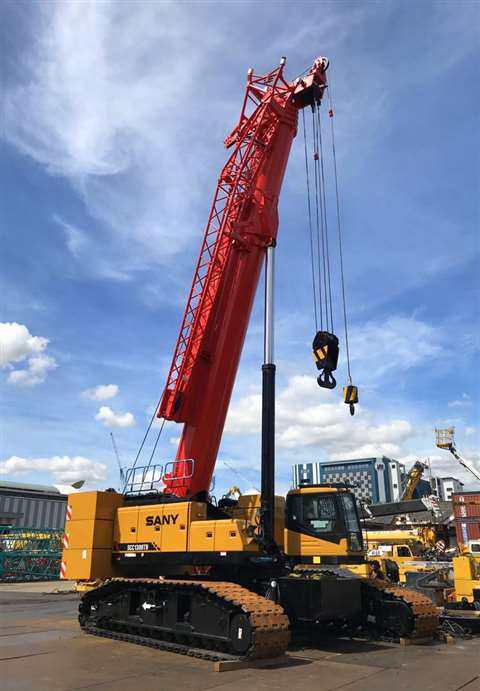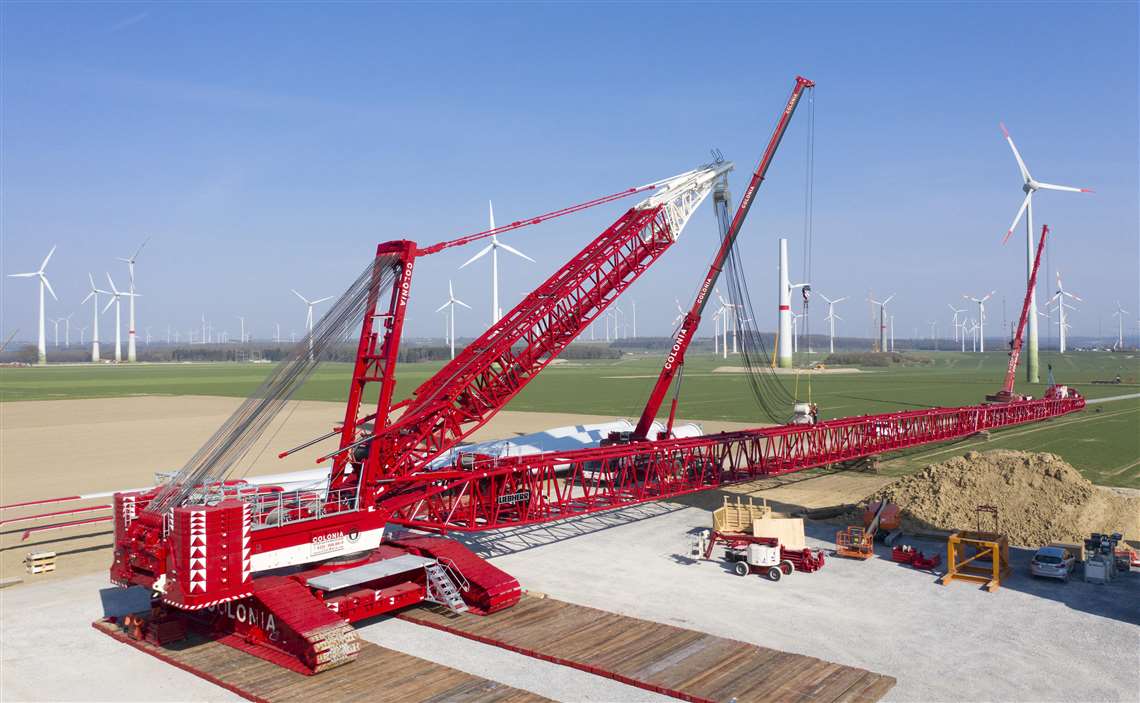Crawler cranes: track stars
04 January 2021
Wind power, infrastructure, industry, real estate, and the marine sector are all referenced in this article as being drivers of demand for the services of crawler cranes. As such, we are seeing a diverse range of job site applications plus a plethora of new models from OEMs looking to meet this demand.
Wind work was a key reason Cologne, Germany-based crane rental house Colonia Spezialfahrzeuge bought one of the first units of the new LR 1800-1.0 crawler crane from Switzerland-headquartered crane manufacturer Liebherr. To date, a total of ten of these cranes have been delivered – with the others going to Spain, the USA, and Asia.
Liebherr first unveiled the 800 tonne class LR 1800-1.0 at its 2018 Customer Days event in Ehingen, Germany, although it was at Bauma 2019 that Colonia Spezialfahrzeuge first saw it. “We wanted to enter the large crawler crane market,” explains Thomas Reuther, sales manager at Colonia Spezialfahrzeuge. “Although the
LR 1800-1.0 was advertised as an industrial crane at Bauma, Liebherr assured us that it was also ideal for wind power equipment. We believe that at the current time a crawler crane is rather dependent on orders from the wind power industry.”
Wind farm work
The first job Colonia Spezialfahrzeuge used the crane for was a wind farm in North Rhine Westphalia. Around 70 vehicles transported the crane’s components to the site where four wind towers from Enercon had already been erected by a Liebherr LTM 11200-9.1 mobile crane and now needed completion.
Crane setup, with a 171 metre main boom and a 12 metre jib, took around six days, although Colonia aims to reduce this to four. For the initial erection Liebherr provided personnel support. To aid fast erection, the LR 1800-1.0 has a hydraulic erection support facility which levels the central crawler section using the outrigger cylinders before the superstructure is added. This is hydraulically controlled from the turntable and no special unit is required. ’Quick connection’ is also available, enabling the superstructure to be hydraulically bolted quickly and safely to the central crawler section and safely. The ballast system is also detachable – also saving time.
Once the crane was erected it was used to install four turbines weighing up to 89 tonnes at a height of 160 metres.
USA crane manufacturer Link-Belt also notes the popularity of its telecrawlers for wind work and reports that, overall, the global lattice crawler and telescopic crawler market is steady. “Demand has increased in the telecrawler market in the 250-ton (235 tonne) class,” says Scott Knight, product manager lattice and telescopic crawler cranes. “In most instances, the ability of the telecrawler to travel over long distances over the life of the project, up to 120 miles in some cases, sets it up well for travelling from tower to tower on large wind projects.
“In the lattice crawler market, cranes in the over 250-ton (235 tonne) class have had good success in 2020, particularly with their luffing attachments.”
The company’s most recent telescopic crawler model is the TCC-800. The new 80 ton (75 tonne) telescopic crawler crane started field-testing in 2020, with first shipments scheduled in fourth quarter 2020.
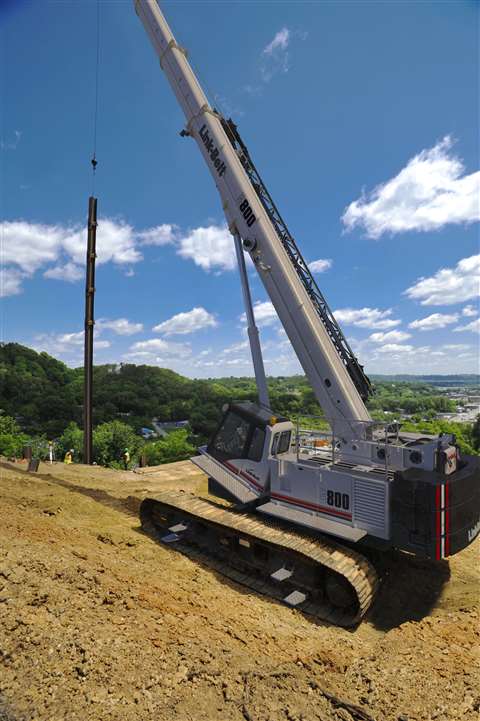
The TCC-800 offers variable side frame track positions (V-CALC) and a new extend/retract system that offers a longer boom than its predecessor, the TCC-750. The TCC-800 comes with a new four-section 38 ft. – 120 ft. (11.8 – 36.5 m) full-power boom that reaches a maximum tip height of 184.5 ft. (56.2 m). The cab has 20 degrees of tilt and is equipped with Link-Belt’s Pulse 2.0 control system.
The 800 will utilises a stage 5 dual-compliant Cummins QSB 6.7 engine with 232 hp at 2000 RPM for greater fuel economy, improved quiet operation and cold-start capability. Pressure read-outs on all hydraulic circuits can be viewed on the Pulse 2.0 display. A vision package with a right-side swing camera, a winch-view camera, and a rear-view camera gives the operator greater jobsite visibility. Single axis or joystick controls are also available, offering operator selectable foot or hand controls for travel operation. Textured paint on all vertical surfaces and slip resistant paint on all horizontal surfaces are designed to improve durability and footing.
Variable displacement pumps provide power control and load sensing on the TCC-800 for smooth functioning of all operating processes. Matching ¾” (19 mm) grooved drums have 841 ft. (256.3 m) of rope capacity with 18,392 lbs. (8 342.2 kg) maximum line pull and 449 fpm (136.8 mpm) maximum line speed. The list chart on the TCC-800 also includes a maximum four-degree list chart for increased performance in varying jobsite conditions.
The TCC-800 self-assembles with 38,500 lbs (17 463kg) of upper counterweight and two 3,000 lb. (1 360 kg) sections of carbody counterweight. For transport, the TCC-800 moves in two loads: main unit transports under 100,000 lbs (45 359 kg) with fly, side frames attached, hook block and ball; overflow includes counterweight sections and stays below 44,500 lbs (20 184 kg). Clearance height on a lowboy transport trailer stays below 13 ft. (3.9 m).
Wind farm work in South Holland, was the reason Barneveld, Netherlands-headquartered crane rental agency Gebri Handel & Verhuur selected to use a 130 tonne capacity Sennebogen 6133 E. The crane is being rented for 15 weeks for the construction of five windmills, moving and lifting tower sections and concrete elements. The crane is on hire from BKV Kraanverhuur and is the first time the crane has been used in the Netherlands.
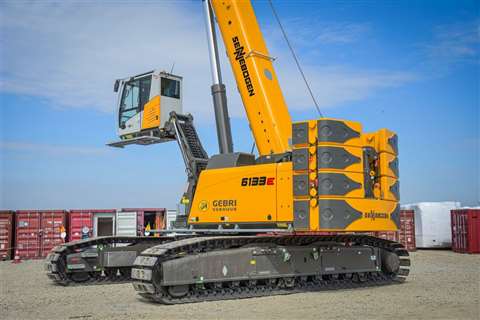
The 6133 E has a six-section boom that has a maximum length of 52 metres. An optional 15 metre top boom is also available. When extended, the crane has a track width of 6.30 metres. The telescopic crawler undercarriage can be retracted to a total machine width of less than 4 metres for transport and moving.
According to Sennebogen, assembly and disassembled is fast and easy, without requiring any additional auxiliary cranes, due to the Starlifter tele-undercarriage self-assembly system.
The crane has Sennebogen’s Maxcab, which can be raised hydraulically by 2.70 m and tilted by 30° (instead of 20° as standard) for good visibility and increased safety on the construction site.
The crane has been painted yellow, in BKV Kraanverhuur’s fleet colour, and is being operated by BKV Kraanverhuur crane driver, Jan van den Berg.
In demand
Kate Lampson, director of strategic communication, at Washington State, USA-headquartered crane manufacturer and rental company Lampson International, observes demand for crawler cranes coming from infrastructure, commercial and residential real estate, powerplants and refineries in the USA and around the world. “There will be a steady demand for this type of equipment well into the future,” she affirms.
One high-profile project the company has been using its Lampson Transi-Lift LTL-2600B heavy lift crawler crane on is the Intel Plant in Hillsboro, Oregon, where it was working at the direction of Hoffman Construction Company and in conjunction with Ness Campbell Crane & Rigging. It was the third phase of the plant expansion, with Lampson International participating in all three phases of the plant construction.
Lampson was hired to lift and set the truss sections of the plants roof structure and to set pipe. It made a total of 32 truss lifts ranging from 116 tons to 277 tons (105 tonnes to 251 tonnes). The largest lift weight was 239 tons (217 tonnes) at a 442 foot radius. Lampson made a jib change on the Transi-Lift from 201 feet at the base configuration to 321 feet to accommodate the setting of air handlers and piping. In total, the crane had 360 feet of main boom for both configurations. “The Transi-Lift also has the smallest footprint of any heavy lift crane on the market today,” says Kate Lampson. “It has the ability to simultaneously pick and carry a load while moving forward, backward and sideways thereby allowing for unmatched maneuverability. It is easily transported via truck, barge or ocean-going vessel to any job site worldwide. It has a quick assembly and disassembly time and is easily adaptable to any lift situation.”
Kate Lampson also highlights a demand, for both rent and sale, for its 350 ton class Lampson Millennium 4600 Crawler Crane from marine services, the oil and gas industry, various port facilities, and infrastructure projects. “With an increased visibility in the operator’s cab as well as the no free fall capabilities, these cranes have become very popular on job sites where traditional friction rigs are no longer allowed,” she qualifies. “The Millennium 4600 combines the structural integrity and versatility of the Manitowoc 4600 with the safety and ease of operation of the new generation hydraulic operating system cranes. The modernised power train consists of an eco-friendly Tier 3/4i Cummins Engine driving state-of-the-art Comer drum planetaries. Operating controls have been modernised with computer enhanced electronic joysticks controlling all operating functions of the crane. The control system allows tandem drum operating abilities for situations requiring endless reeving. All Millennium series cranes are equipped with LSI load monitoring systems to further enhance safe lift operations.”
Japanese manufacturer Sumitomo Heavy Industries Construction Cranes Co Ltd (HSC) has launched a new crawler crane: the 175 tonne capacity SCX1800A-3 lattice boom hydraulic crawler. It has a main boom up to 84 metres and the maximum main boom and crane jib combination is 75 + 31 metres. It is designed to offer “outstanding work capabilities within a refined compact body combined with superb transportation and assembly system.”
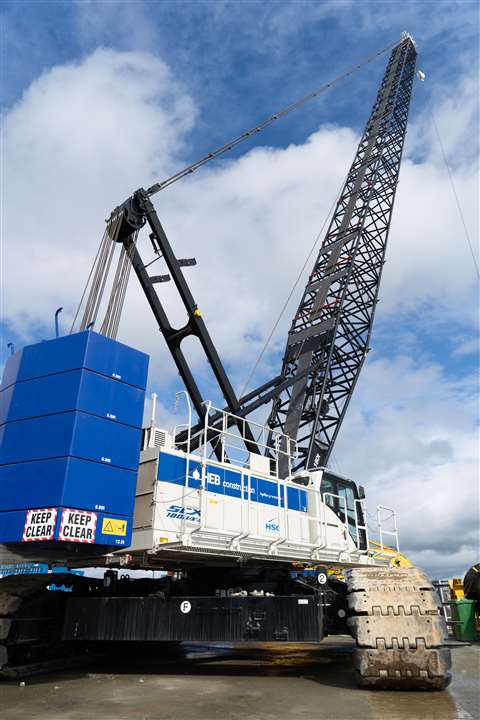
While the name suggests 180 tonnes capacity, this is available with the addition of special equipment. A heavy duty top gives 180 tonnes at 4.1 metres radius with a 12 metre main boom. Standard is 160 tonnes at 4.5 metres radius.
An auxiliary sheave option offers greater lifting performance and caters to increasingly diverse customer requirements, the manufacturer said.
Power is from a Cummins QSB6.7 diesel engine, either to EU Stage Ⅳ / US Tier 4 final or EU Stage Ⅲ A / Tier 3 exhaust emission regulations. An ECO winch and auto idle stop function are designed to allow operations using less fuel. Unnecessary fuel consumption has been reduced so that there is less impact on the environment, Sumitomo said.
Easy transport and assembly were primary considerations. Total weight for transport, including lower boom, winch rope and mast is given as 40.8 tonnes. The main crane body weighs 27.6 tonnes. All parts remain within 3.2 metres for transport. A new counterweight design sees the same slabs used for left and right, including the base, to help speed up and simplify assembly.
One of the first customers to receive an SCX1800A-3 was New Zealand-based civil construction company HEB Construction, part of Vinci Construction. HEB has been using the crane on a large project at Port of Napier. “We chose this model because we were looking for a 150-180 tonne crawler crane suitable for piling operations,” says HEB’s national plant manager, Grant Moffat. “It can be difficult to find a crane that is heavy duty enough, and with the high line pull required for piling works, without compromising on lifting ability. This crane does it all.”
HSC has also sold a 100 tonne capacity HSC SCX1000A-3 crawler crane and a 275 tonne HSC SCX2800A-3 crawler to Norwegian rental house Roar Wilhelmsen. The 100 tonner was delivered in the first week of August 2020 and was put to work on the Vestfoldbanen double-track railway project south of Oslo. The SCX2800A-3 was delivered to Trondheim. Training was given there by Norwegian HSC dealer ANK Cranes and HCME NL. It was then put directly to work.
The SCX2800A-3 was ordered with 85 metre boom, 45.7 metre luffing jib and the luffing jib winch.
Commenting on his new purchase Hans Roar Wilhelmsen, COO, said, “This investment is a part of our expansion plan for crawler cranes. We have seen growth in the market in recent years and we are happy to welcome the two HSC Cranes to our rental fleet.”
Roar Wilhelmsen AS was established 60 years ago. It has operations in Oslo, Trondheim and Elverum. The fleet of all terrain, crawler and knuckle boom cranes ranges from 1 to 350 tonnes lifting capacity. There is also a transport business and a fleet of excavators.
As we can see the crawler crane’s remit is wide - both geographically and in job type. With the wind sector, in particular, continuing to grow globally, the crawler’s future looks even more secure. It’s no wonder OEMs are investing in developing so many new models.
Workaholic crawler
Ohio, USA-based tunnelling specialist Triad Engineering & Contracting used a Manitowoc MLC100-1 lattice-boom crawler crane for months on end, working double shifts, with no issues.
The company received its Manitowoc MLC100-1 in August 2019 and set it to work on the London Road Relief Sewer project, situated on the east side of Cleveland, Ohio. Operating continuously over two shifts a day, the machine notched up 2,500 hours of faultless operation within its first 12 months.
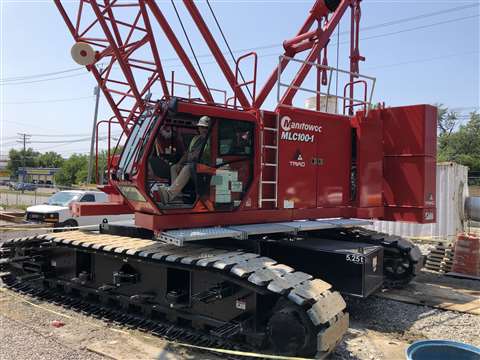
New Crawler Crane CC1908S-1
Japanese crane manufacturer Maeda has launched the 8.1 tonne capacity CC1908S-1 mini crawler crane. It is the largest model in the series with a five-section main boom offering a 20.1 metre maximum tip height and a maximum radius of 19.2 metres. Supplied with the optional 1.5 tonne fully hydraulic luffing jib - which provides a tip height of 26 metres - features include Stage V diesel power, a 3.5 tonne pick and carry capacity, a 360 degree camera system, optional blade, and full control radio remote system.
Manitowoc launches 150 tonne crawler
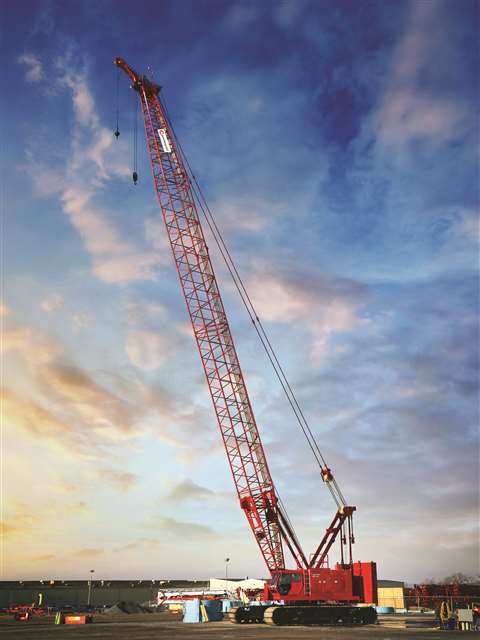
A 150 tonne (165 US ton) capacity MLC150-1 lattice boom crawler crane has been announced by Manitowoc Cranes.
The MLC150-1 joins the 100 tonne MLC100-1 in the lower capacity range formerly covered by Manitowoc-branded Kobelco crawlers. They were sold mostly in the USA under a now-defunct distribution agreement with the Japanese manufacturer.
Maximum main boom length is 78 metres and a 24 metre fixed jib can be added. Capacity on that is 27 tonnes. Also available is a 52 metre luffing jib that lifts 46 tonnes.
Brennan Seeliger, Manitowoc Cranes product manager, said, “We have had great feedback on the MLC100-1, so we based the new MLC150-1 on that model, but boosted the capacity for the 165 US ton (150 tonne) class.”
A feature of this new model is quicker assembly than previous models, the manufacturer said. Self-assembly without the boom top is facilitated by a boom butt-mounted sheave. The boom cap, jib butt and struts ship as a single package for fewer connections, the company explained. It is designed to be transported using a minimum of permitted loads.
“Users will really like the upgrades to the cab in the MLC150-1,” Seeliger said. “While this crane has great capacity and reach for the 150 US tonne class, improved transport and erection efficiencies are always something users like to see.”
Also listed alongside the MLC100-1 and MLC165-1 models in the company’s lower capacity product range are the MLC80A-1, MLC90A-1 and MLC100A-1.
Tadano Mantis showcases new telecrawler
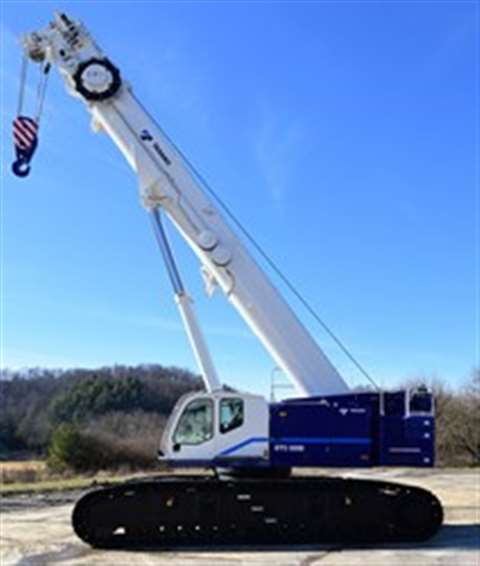
The Tadano Mantis Corporation has launched a new 160 ton (145 tonne) capacity GTC-1600 model telescopic crawler crane.
It has a six-section hydraulic boom that extends between 42.8 feet to 200.1 feet (13.1 metres to 61 metres).
The crane also has a 33.8 foot / 59.1 foot (10.3 metre / 18.0 metre) bi-fold jib with offsets at 0, 20, and 40 degrees. A jib length of up to 105.0 feet (32 metres) is possible with two 23.0 foot (7 metre) optional lattice inserts, giving a maximum tip height of up to 305 feet (93 metres).
An optional 11.8 foot (3.6 metre) heavy lift jib with 20 and 40 degree offsets is useful for tilt-up work in tight spaces, said Tadano Mantis. Mechanical offset on all jibs is standard, with optional hydraulic offset available.
The GTC-1600 is designed for easy set-up due to features such as a self-erecting counterweight system with a remote control, as well as integrated carbody jacks and hydraulic quick couplers for track drive hose bundles – which Tadano Mantis says allow easy track frame removal and handling.
Tadano telecrawler official launch

Tadano has launched the 150 tonne-plus capacity GTC-2000 telescopic boom crawler crane for the North American market. It is also being sold as the GTC-1800EX for the rest of the world. The crane was first seen as the Terex’s Demag TCC 160 concept at Bauma 2019.
The GTC-1800EX lifts more than 150 tonnes and has a maximum load moment rating of 590 tonne-metres, effectively closing the gap between the 130 and 220 tonne capacity telecrawler classes.
Its main boom is 60 metres and extensions of 5, 11, 17, and 23 metres can be added. These can be mechanically and hydraulically offset and will give a maximum system length of 83 metres. The five-metre extension can be folded onto the side of the main boom for transport to save space.
The crawler tracks’ drives can be controlled via a joystick by the operator and they provide up to 1,450 kN of traction force, claimed as the highest in its class. Gradeability is given as 50 percent, while maximum travel speed is 2.1 km/h. Ground clearance is 420 millimetres and bolt-on double grouser shoes or flat track shoes are available to aid traction.
The width of the crane’s crawler tracks can be adjusted. There are three standard widths, of 3.5, 4.75 and 6 metres, as well as continuously variable track widths, which can also be used in an asymmetrical configuration. The tracks can be adjusted both when stopped or when travelling, while the control system monitors the relevant parameters to ensure the crane remains within an allowable configuration. The control system is based on the Demag IC-1 Plus control system and automatically determines the permissible lifting capacity taking into account ground incline, slewing angle, and track adjustment. The crane also has IC-1 Remote telematics system technology.
Dimensions for transport are 3 metres (width and height). The heaviest component for transport, the basic crane, weighs 47 tonnes although this can be reduced to 42 tonnes by removing the extension beams used to adjust the track width. The two crawler side frames each weigh 18.5 tonnes with one-metre track shoes; the two central ballast pieces weigh 7.5 tonnes each; and the counterweights, including the base plate, weigh 45 tonnes. The maximum operating weight of the crane is just under 150 tonnes.
Most of the GTC-1800EX’s hydraulic couplings are the quick-connect type designed to aid fast fast and efficient work. The crane has permanently installed outriggers, including the pads which, Tadano said, enable the base crane to be conveniently unloaded from a lowbed trailer. Self-assembly includes the installation of two 7.5 tonne central counterweights that mount on the carrier, the crawler frames, the 45 tonne upper counterweight that stacks on the superstructure and the second hoist.
To maximise working efficiency, the crane can be fuelled while on a lowbed trailer, and the cab can be easily accessed during setup to start the machine for self-assembly, explained Tadano. Permanent ladders (and ladder attachment points for the included loose ladder) are located strategically around the crane for access to key components during all stages. The crane also has anchors for a personal fall protection system at the intended ladder support points.
Power is from an MTU 6-cylinder engine with an output of 230 kW and a torque of 1,300 Nm. This engine complies with Euromot 5 specifications, as well as with Tier 4 Final specifications for the US market. There are two operating modes that Tadano is keen to highlight: at a speed of 1,500 min-1, the diesel engine will run in an ECO mode that optimises fuel consumption; while at a speed of 1,800 min-1 a Power Boost function is available which provides an output increase and makes it possible to carry out simultaneous movements at high output or speed during crane operation.
The primary and auxiliary hoists of the GTC-1800EX are technically identical, with both featuring a 245 metre, 26 mm diameter, wire rope with a high line pull of 13.9 tonnes. The wire rope’s high line pull makes it possible to lift heavy loads with low reeving, saving time during setup and re-reeving.
“Our goal is to become ‘One Tadano’. With the first telecrawler produced in Germany and branded by Tadano, this vision is now becoming a reality,” said Ingo Nöske, director product management, crawler cranes at Tadano .“With the integration of the GTC-1800EX into the Tadano brand, we’re bringing the lone warrior into the family, so to speak. The situation is different with the AC and CC cranes. These will continue to be marketed under the Demag brand.”
Sany America debuts two crawler cranes
Sany America has unveiled two new lattice boom crawler cranes for the North American market: the SCA1000A and SCA2600A.
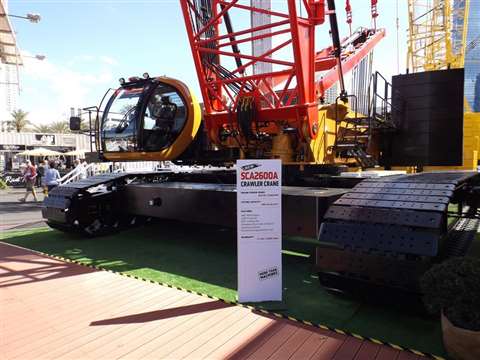
The SCA1000A and SCA2600A models originate from the Sany Group’s existing crawler portfolio but, according to the manufacturer, have been “specifically refined for the North American market”.
Sany said they are specifically suitable for road and bridge construction, oil and gas projects, and other large commercial jobs. Larger of the two is the SCA2600, which liftS 286 US tons (260 tonnes) at 16.4 feet (5 metres) radius. Maximum main boom is 302 feet (92 metres) and there are 138 foot (42 metre) fixed jib and 207 foot (63 metre) luffing jib options. The engine delivers 450 hp at 1,800 min-1.
The new models come with all options and attachments included in the base price as standard, according to Mark Thurston, director of crane sales at Sany America. “The cranes are designed with best-in-class components from Cummins, Kawasaki, Rexroth and Zollern,” said Thurston. “High-quality components coupled with enhanced designs ensure high levels of uptime and efficiency, which is critical to operators on the ground. We’re confident in our machines.”
Sany Cranes come with a three-year, 3,000-hour standard warranty.
The company said even larger tonnage crawler cranes will be available in North American later in 2020. In addition, a new line of rough terrain cranes is scheduled for release in 2021.
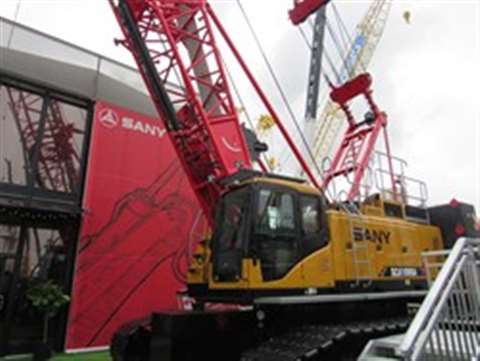
Clausen adds tele crawler
Swiss crane rental specialist Clausen has added a second LTR 1060 telescopic boom crawler crane to its alpine fleet. It follows the initiation of its first Liebherr LTR 1060 in 2013. Faster set up time and outstanding offroad ability were key factors in the decision, Liebherr said. It is planned for jobs on mountain sites involving steep, difficult access in the Pennine Alps, the manufacturer said.
Clausen Kran is a family business opened in 1972 in Brig im Wallis. The area is known as having the most mountains above 4,000 metres in the Alps. Some of the local ski resorts are as high as 3,000 metres above sea level. New cable cars are being built and old ones need to be removed.
Geri Clausen, company owner, was one of the first crane contractors to use a telescopic crawler crane in these extreme conditions, Liebherr said. “The LTR 1060 has proven excellent on gravel tracks with very tight bends and steep slants as well as gradients of up to 40 percent. We have often taken it to altitudes of over 3,000 metres. Once it arrives at the site, the LTR 1060 can be made ready for action extremely quickly. The machine has had no problems, we are very satisfied.”
Cornelia Clausen-Ogi said: “The LTR 1060 is a compact machine and can be moved very quickly and easily on the site. In addition, the crawler crane can move heavy loads. That is a major benefit”.
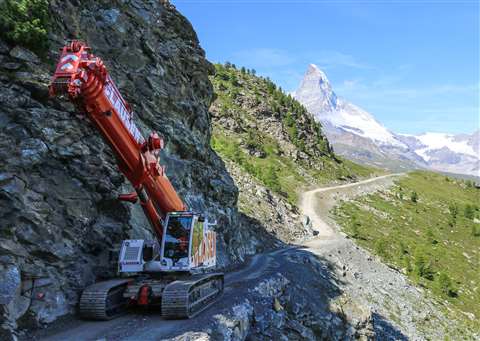
Sany launches 130 tonne tele boom crawler crane
Chinese manufacturer Sany has launched the largest model in its TB series of telescopic boom crawler cranes: the 130 tonne capacity SCC1300TB.
It has a 60 metre boom in six sections and there is an 18.1 metre fixed jib. It offers a short set-up time, good handing and manoeuvrability, the company said. Its maximum load moment is given as 4,800 kN-m. Pick and carry capability is 50 per cent higher than with conventional lattice boom crawlers, Sany said.
Operator comfort is enhanced by a new improved operator cab with a list of features that includes panoramic sunroof and 10.4-inch touchscreen.
Sany said the SCC1300TB can work in conjunction with a rotary drilling rig to assist with installation of steel cages, carry out high voltage electric power line work, and help with auxiliary wind power jobs.
Moving further east, Japanese manufacturer Sumitomo Heavy Industries Construction Cranes Co Ltd (HSC) has also launched a new crawler crane: the 175 tonne capacity SCX1800A-3 lattice boom hydraulic crawler. It has a main boom up to 84 metres and the maximum main boom and crane jib combination is 75 + 31 metres. It is designed to offer “outstanding work capabilities within a refined compact body combined with superb transportation and assembly system.”
While the name suggests 180 tonnes capacity, this is available with the addition of special equipment. A heavy duty top gives 180 tonnes at 4.1 metres radius with a 12 metre main boom. Standard is 160 tonnes at 4.5 metres radius.
An auxiliary sheave option offers greater lifting performance and caters to increasingly diverse customer requirements, the manufacturer said.
Power is from a Cummins QSB6.7 diesel engine, either to EU Stage Ⅳ / US Tier 4 final or EU Stage Ⅲ A / Tier 3 exhaust emission regulations. An ECO winch and auto idle stop function are designed to allow operations using less fuel. Unnecessary fuel consumption has been reduced so that there is less impact on the environment, Sumitomo said.
Easy transport and assembly were primary considerations. Total weight for transport, including lower boom, winch rope and mast is given as 40.8 tonnes. The main crane body weighs 27.6 tonnes. All parts remain within 3.2 metres for transport. A new counterweight design sees the same slabs used for left and right, including the base, to help speed up and simplify assembly.
